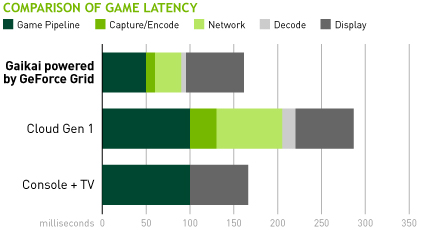But what are the business models of the 2 services?
Onlive seems to work on lower-end hardware, requires subscription and purchases of certain games at full retail prices?
Gaikai requires better hardware, requires subscription and full retail price for games?
Here's a detailed explanation taken from this thread:
http://onlivefans.com/showthread.ph...sons-debates-tech-discussion-and-such-IN-HERE
Onlive:
For consumers, they are primarily a Software-as-a-Service (SaaS) company selling games and offering demos directly to the consumer. OnLive doesn't require a subscription. There is an optional subscription for back catalog games. OnLive offers free 30 minute demos for the majority of their titles. However, the are now partly an Infrastructure-as-a-Service (IaaS)/Platform-as-a-Service (PaaS) company due to their OnLive desktop Service.
They are working on getting their OnLive client integrated with HDTVs, tablets, smartphones, bluray players, etc in addition to the PC/Mac. We have not heard about the OnLive client coming to Linux (for those who care).
For publishers, OnLive is a Platform-as-a-Service (PaaS) company. They allow hosting of games for demo and sale. They also get ad revenue from publishers when users play demos. OnLive gets around a 30 percent profit from direct sales to consumers. They also have created instant demo, probably in response to Gaikai, which launch directly into games. It seems that Onlive does not share ad revenue, and they do not have affiliate sites to host links to their instant demos. OnLive offers a SDK to enable various features. However, some games have been ported without the SDK.
- Centralized gaming platform to compete with other distribution platforms (consoles/steam/d2d)
- Community based
- Aimed for consumers
Gaikai:
For consumers, they do not offer any services directly. They just deliver technology that enables users to play games through the cloud. Gaikai is not a centralized platform for consumers, and you cannot buy games directly from Gaikai. They are working on getting Gaikai-enabled games working on HDTVs, tablets, smartphones, etc (basically anything that has a web brower or streams video) in addtional to PC/Mac/Linux. Consumers are able to play demos powered by Gaikai embedded on many sites such as
www.gaikai.com/games and
www.eurogamer.net/gaikai
For publishers, Gaikai is a Platform-as-a-Service (PaaS) company with an advertising slant. They allow publishers/developers to host games for demo and for sale (requires private cloud hosting). However, they do not get profit from the sale. That profit goes directly to publishers/developers/retailers. They primarily get profit from ad revenue from publishers when users play demos and the cost of hosting private clouds (which facilitates full game streaming and free2play games) for developers/publishers. Gaikai shares ad revenue with affiliate sites that host links to their instant demos. Gaikai offers a SDK to enable various features like touch controls, etc. However, they emphasize that all games can been ported with no effort from developers/publishers.
They allow publishers/developers to host full games and free to play games by creating private clouds, which can integrate into the publishers/developers storefront. Gaikai does offer payment services if the publisher/developer wishes to use them. Gaikai does not take a cut of sales.
For retailers, Gaikai is like an advertisement company that can supply demos and redirect users back to the retailer site for final sale. Obviously, Gaikai will also generate ad revenue from the retailer as well. Also, Gaikai will allow full game streaming on retail sites very soon after they launch a portal on Facebook. The retailer will have to pay for the number of permanent instances needed to host the full streaming games.
For gaming websites/affiliates, Gaikai will share ad revenue (50/50) for Gakai enabled game demos users play on your site. All you need to do is add a snippet of code to your website to enable Gaikai demos.
- Alternative distribution system for publishers for demos or full games
- You will not be purchasing or demoing games from Gaikai, you will purchase them from the game developer's (or publisher's) website
- Not a centralized platform like Onlive (you will need to visit each publisher's site to use their streaming version of the game)
- Not a product for consumers. It is a product -only- for game studios to purchase and utilize. Regular customers will never have access.
- Not intended to compete with any current gaming platforms (consoles/steam/d2d/etc) It's simply another way publishers and developers can get their game out there on their own.
- Partly ad driven with profits going to both Gaikai and the affliiate websites (Eurogamer, Escapist) that host links to Gaikai enabled demos

